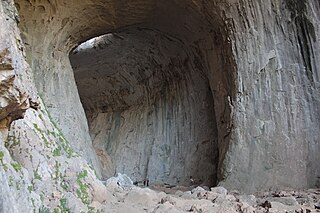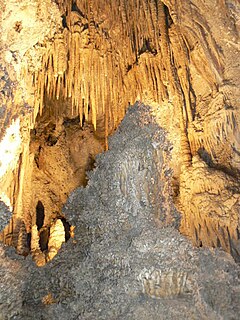 W
WThe Bacho Kiro cave is situated 5 km (3.1 mi) west of the town Dryanovo, Bulgaria, only 300 m (980 ft) away from the Dryanovo Monastery. It is embedded in the canyons of the Andaka and Dryanovo River. It was opened in 1890 and the first recreational visitors entered the cave in 1938, two years before it was renamed in honor of Bulgarian National Revival leader, teacher and revolutionary Bacho Kiro. The cave is a four-storey labyrinth of galleries and corridors with a total length of 3,600 m (11,800 ft), 700 m (2,300 ft) of which are maintained for public access and equipped with electrical lights since 1964. An underground river has over time carved out the many galleries that contain countless stalactone, stalactite, and stalagmite speleothem formations of great beauty. Galleries and caverns of a 1,200 m (3,900 ft) long section have been musingly named as a popular description of this fairy-tale underground world. The formations succession: Bacho Kiro’s Throne, The Dwarfs, The Sleeping Princess, The Throne Hall, The Reception Hall, The Haidouti Meeting-Ground, The Fountain and the Sacrificial Altar.
 W
WDevetàshka cave is a large karst cave around 7 km (4.3 mi) east of Letnitsa and 15 km (9.3 mi) northeast of Lovech, near the village of Devetaki on the east bank of the river Osam, in Bulgaria. The site has been continuously occupied by Paleo humans for tens of thousands of years, served as a shelter for various faunal species during extensive periods and is now home to nearly 30,000 bats.
 W
WDevil's Throat Cave, or Dyavolsko Garlo, is located in the western Rhodopes close to the village of Gyovren in Bulgaria, near its border with Greece. A popular tourist attraction, Devil's Throat branches from Trigrad Gorge.
 W
WKozarnika or Peshtera Kozarnika is a cave in northwestern Bulgaria that was used as a hunters’ shelter as early as the Lower Paleolithic. It marks an older route of early human migration from Africa to Europe via the Balkans, prior to the currently suggested route across Gibraltar. The cave probably keeps the earliest evidence of human symbolic behaviour and the earliest European Gravette flint assemblages came to light here.
 W
WLedenika is a cave in the Northwestern parts of the Balkan Mountains, 16 km away from the Bulgarian city of Vratsa. Its entrance is approximately 830 m above sea level. The cave features an abundance of galleries and impressive karst formations including stalactites and stalagmites. It was first discovered around the beginning of the 20th century and has been open to tourists since 1961. Ledenika Peak on Graham Land in Antarctica is named after the cave, in recognition of its cultural importance.
 W
WThe Magura Cave is located in north-western Bulgaria close to the village of Rabisha, 25 km (16 mi) from the town of Belogradchik in Vidin Province.
 W
WOrlova Chuka is a cave situated in the Danubian Plain, north-eastern Bulgaria. With a total length of 13,437 m, Orlova Chuka is the second longest cave in the country after Duhlata. The cave was discovered in 1941 and opened for tourists in 1957. Orlova Chuka is home to 14 species of bats.
 W
WProhodna is a karst cave in north central Bulgaria, located in the Iskar Gorge near the village of Karlukovo in Lukovit Municipality, Lovech Province. The cave is known for the two eye-like holes in its ceiling, known as God's eyes.
 W
WSaeva dupka is a cave in northern Bulgaria near the village of Brestnitsa, Lovech Province. The cave has naturally formed 400 meters of corridors and halls. The cave has hosted many choral music performances, thanks to the excellent acoustic conditions. Saeva dupka was named after two brothers, Seyu and Sae, who used it as a hiding place during the Ottoman occupation of Bulgaria. Recent excavations have shown the cave was inhabited since Roman times. Saeva dupka is one of the 100 Tourist Sites of Bulgaria.
 W
WSnezhanka is a show cave in the Rhodope Mountains, 5 km away from the town of Peshtera, southern Bulgaria. It was discovered in 1961. The cave is 145 metres long, with a constant annual temperature of 8 °C, and was formed by the Novomahlenska River 3.5 million years ago.
 W
WUhlovitsa is a show cave in the Blue Pools Area in the Smolyan Province of the Rhodope Mountains, southern Bulgaria. The cave is close to Mogilitsa village and 37 and 47 km away from Pamporovo and Chepelare respectively. About 3000 tourists visit the cave every year.
 W
WThe Wine Museum is a museum of wine and viticulture located in Pleven, a city in north central Bulgaria. Opened on 17 September 2008, the museum occupies a natural cave in Pleven's Kaylaka park, about 5 kilometres (3.1 mi) from the city centre.
 W
WYagodinska Cave is a cave in the Rhodope Mountains, southern Bulgaria. It is included in the 100 Tourist Sites of Bulgaria under № 89. It is named after the homonymous village nearby. With a total length of 10,500 m, Yagodinska is the third longest cave in the country after Duhlata and Orlova Chuka and the longest in the Rhodopes. Yagodinska Cave is home to 11 species of bats.